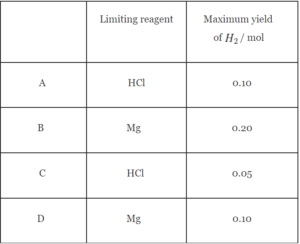Question
0.20 mol of magnesium is mixed with 0.10 mol of hydrochloric acid.
Mg (s) + 2HCl (aq) → MgC (aq) +
(aq) +  (g)
(g)

▶️Answer/Explanation
Ans: C
1 mol of Mg requires 2 moles HCl.
0.2 mol Mg will require 0.4 moles HCl.
Since we have only 0.1 mol HCl, hence, it is the limiting reagent.
2 mol HCl forms 1 mol H2.
0.1 mol HCl will form 0.05 mol H2.
Question
What volume of carbon dioxide, in dm\(^3\) under standard conditions, is formed when 7.00 g of ethene \(({{\text{C}}_2}{{\text{H}}_4}{\text{, }}{M_{\text{r}}} = 28.1)\) undergoes complete combustion?
A. \(\frac{{22{\text{.}}4 \times 28{\text{.}}1}}{{7{\text{.}}00}}\)
B. \(\frac{{22{\text{.}}4 \times 7{\text{.}}00}}{{28{\text{.}}1}}\)
C. \(\frac{{2 \times 22{\text{.}}4 \times 28{\text{.}}1}}{{7{\text{.}}00}}\)
D. \(\frac{{2 \times 22{\text{.}}4 \times 7{\text{.}}00}}{{28{\text{.}}1}}\)
▶️Answer/Explanation
D
C2H4(g) + 3O2(g) → 2CO2(g) + 2H2O(l)
Molar mass of ethene = 28.1 g (Given)
7 g of ethene contains 7/28.1 moles ethene
1 mole C2H4(g) gives 2 moles of CO2(g)
7/28.1 moles C2H4(g) will form \(\frac{{2 \times 7{\text{.}}00}}{{28{\text{.}}1}}\) moles CO2(g)
Volume of 1 mole CO2(g) is 22.4 dm\(^3\),
Volume of CO2(g) formed = \(\frac{{2 \times 22{\text{.}}4 \times 7{\text{.}}00}}{{28{\text{.}}1}}\) dm\(^3\)
Question
What mass, in g, of hydrogen is formed when 3 mol of aluminium react with excess hydrochloric acid according to the following equation?
\[{\text{2Al(s)}} + {\text{6HCl(aq)}} \to {\text{2AlC}}{{\text{l}}_{\text{3}}}{\text{(aq)}} + {\text{3}}{{\text{H}}_{\text{2}}}{\text{(g)}}\]
A. 3.0
B. 4.5
C. 6.0
D. 9.0
▶️Answer/Explanation
D
2 moles of Al forms 3 moles of Hydrogen gas
3 moles of Al will form 4.5 moles of Hydrogen gas
Mass = 4.5*2 = 9g
Question
Four identical containers under the same conditions are filled with gases as shown below. Which container and contents will have the highest mass?

▶️Answer/Explanation
B
Since the containers are identical, they will have equal volume of gases hence equal number of moles of gases.
Then, gas having highest molar mass will have highest mass.
Here, Oxygen has highest molar mass (32 g) among these gases.
Question
Which graph represents the relationship between volume and pressure for a fixed mass of gas at constant temperature?

▶️Answer/Explanation
D
PV = nRT
For fixed mass n is constant and at constant temperature,
PV = constant
V= constant*(1/P)
y=mx i.e. Linear graph as shown in D.
Question
7.102 g of Na2SO4 (M = 142.04 g mol–1) is dissolved in water to prepare \({\text{0.5000 d}}{{\text{m}}^{\text{3}}}\) of solution. What is the concentration of \({\text{N}}{{\text{a}}_{\text{2}}}{\text{S}}{{\text{O}}_{\text{4}}}\) in \({\text{mol}}\,{\text{d}}{{\text{m}}^{ – 3}}\)?
A. \(2.500 \times {10^{ – 2}}\)
B. \(1.000 \times {10^{ – 1}}\)
C. \(1.000 \times 10\)
D. \({\text{1.000}} \times {\text{1}}{{\text{0}}^{\text{2}}}\)
▶️Answer/Explanation
B
Number of moles = 7.102/142.04 = 0.05 moles
Volume = \({\text{0.5000 d}}{{\text{m}}^{\text{3}}}\)
Concentration = 0.05/0.5 = 0.1 \({\text{mol}}\,{\text{d}}{{\text{m}}^{ – 3}}\) = \(1.000 \times {10^{ – 1}}\) \({\text{mol}}\,{\text{d}}{{\text{m}}^{ – 3}}\)
Question
Under which conditions does \({\text{C}}{{\text{H}}_{\text{4}}}\) have the same number of molecules as \({\text{100 c}}{{\text{m}}^{\text{3}}}\) of \({{\text{O}}_{\text{2}}}\) at 27 °C and \(1.0 \times {10^5}{\text{ Pa}}\)?

▶️Answer/Explanation
D
\(n= \frac{P\times V}{R\times T}\)
For same number of molecules, number of moles would be same.
For \({{\text{O}}_{\text{2}}}\) , T = 27+273 = 300K
\(n= \frac{10^5\times P\times V}{R\times T}\)
\(n= \frac{10^5\times 1\times 0.1}{R\times 300}\)
For \({\text{C}}{{\text{H}}_{\text{4}}}\)
Option A, \(n= \frac{10^5\times 1\times 0.05}{R\times 327}\)
Option B, \(n= \frac{10^5\times 1\times 0.05}{R\times 600}\)
Option C, \(n= \frac{10^5\times 2\times 0.1}{R\times 327}\)
Option D, \(n= \frac{10^5\times 2\times 0.1}{R\times 600}\) = \(n= \frac{10^5\times 1\times 0.1}{R\times 300}\) = Number of moles of \({{\text{O}}_{\text{2}}}\) .
